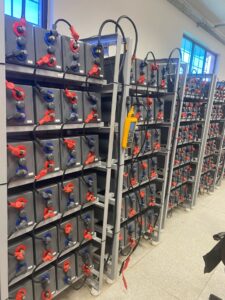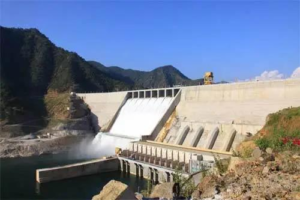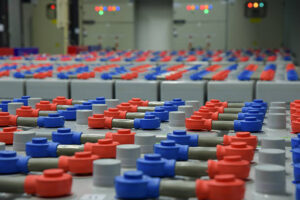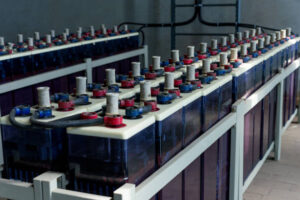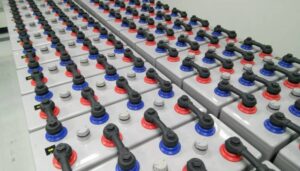What is the lead acid battery ?
A lead acid battery is a rechargeable battery that utilizes a controlled chemical reaction between lead and sulphuric acid to produce electricity. This chemical reaction is reversed during recharging.

Lead Acid batteries has the future of great performance at low and high temperature , stability and reliability , high safety . Although lead acid batteries has a low energy density and high maintenance, they are widely used in photovoltaic systems due to their long lifetime and low cost compared to other battery types. They are also commonly used for most rechargeable battery applications, such as backup power battery, energy storage battery, starting battery and power battery and have a well-established, mature technology base.
What is the structure of lead acid battery ?

Figure 2.1
The lead acid battery is mainly made of electrode (Positive electrode and negative electrode) , cell divider and electrolyte solution and protective casing . You can view the diagram as the figure 2.1
What is application of lead acid batteries ?
Lead acid batteries are applied in backup power batteries ,energy storage batteries , starting batteries , motive batteries.
Backup power batteries : UPS, communication and telecom backup power, Emergency power supply .
Energy storage batteries : new energy storage batteries,
Staring batteries: electric vehicle, helicopter,
Motive batteries: electrocar, golf car, forklift , truck,
What is the type of lead acid batteries ?
Batteries commonly used in our daily lives can be classified into three categories: ordinary batteries, dry-charged batteries, and maintenance-free batteries.
Ordinary batteries are composed of lead and lead oxides plates and an electrolyte solution of sulfuric acid. They have the advantage of a stable voltage and low cost but are disadvantaged by low specific energy (i.e., the amount of electric energy stored per kilogram of battery), a short service life, and requiring frequent maintenance.
Dry-charged batteries, also known as dry-charged lead-acid batteries, have a high power storage capacity in their negative plates. They can store power for up to two years in a completely dry state, and when needed, the electrolyte can be added, and the battery can be used within 20-30 minutes.
Maintenance-free batteries have a structural advantage that allows them to consume very little electrolyte, and they do not require regular addition of distilled water during their service life. They are also resistant to shocks and high temperatures, have a smaller size, and a lower self-discharge rate. They have a longer service life, generally twice that of ordinary batteries.
VRLA battery is short for valve regulated lead battery. They are designed with a pressure relief valve that regulates the internal pressure and prevents the release of gas, making them completely sealed and preventing electrolyte evaporation.
There are two types of VRLA batteries: absorbed glass mat (AGM) and gel. AGM batteries use a glass mat to absorb the electrolyte, while gel batteries use a thickened electrolyte that immobilizes the acid. Both types of VRLA batteries have their own unique advantages and are commonly used in applications that require a reliable and maintenance-free power source, such as backup power systems, solar energy storage, and telecommunications equipment.
Here are the frequency asked question about VRLA Batteries ?
1)What is the depth of discharge? What does it mean of 20% the depth discharge ?
Answer: The depth discharge of batteries refers to the amount of compacity which has been released during the discharge, typically expressed as a percentage. When the discharge depth up to 20%, it means that the battery capacity has reached 20% of battery rated capacity .
2) What are the advantage of VRLA battereis compared to traditional open lead acid batteries?
Answer: VRLA batteries offer several advantages over traditional open lead-acid batteries. They do not require some maintenances such as adding acid and water, or adjusting the specific gravity of acid. They have a sealed structure that prevents acid leakage and foggy discharge. Their electrolyte does not flow, allowing them to be installed vertically or horizontally. In addition, they do not need a dedicated cell chamber and can be used in combination with other equipment. it can make them more versatile and space-efficient.
3) What is the function of VRLA batteries safety valve?
Answer: The safety valve of VRLA Battery is designed to prevent too high internal pressure of the battery. When the internal pressure up to a certain value, the safety valve automatically opens to relieve the pressure. When the pressure returns to normal, it closes again. This one-way safety valve helps to ensure safe operation of the battery.
4) What is the normal open and closed valve pressure of the safety valve?
Answer: According to communication standard YD/T 799-2002, the valve opening pressure of a VRLA battery should be between 10-35kPa, while the closing valve pressure should be between 3-15kPa. The electric power standard DL/T 637-1997 requires a valve opening pressure of 10-49kPa and a closing valve pressure of 1-10kPa.
5)What factors are related to the service life of VRLA batteries?
Answer: The service life of a VRLA battery is influenced by several factors, including its design and manufacturing, as well as the correct use and maintenance by the customer. Proper storage, charging, and operating conditions can all affect the longevity of the battery. service life of a VRLA battery is influenced by several factors, including its design and manufacturing, as well as the correct use and maintenance by the customer. Proper storage, service life of a VRLA battery is influenced by several factors, including its
6)Under what ambient temperature can VRLA batteries be used? What is the best range to control the ambient temperature?
Answer: VRLA batteries can be used in environments with an ambient temperature ranging from -15°C to -45°C. However, it is recommended to control the ambient temperature within a range of 5°C to 30°C, with the optimal temperature being between 15°C to 25°C.
7)What is the single open circuit voltage of a VRLA battery?
Answer: Generally, the single open circuit voltage of a VRLA battery ranges from 2.11-12.14V, and it is considered normal if it is greater than 2.10V after leaving the factory.
8) What inspection should be done after VRLA battery is installed?
Answer: After the battery is installed, the following checks should be done:
a) Check whether the conductive connection bolts are tightened one by one;
b) Whether the battery connection is consistent with the installation drawing requirements;
c) Check whether the total voltage of the battery is normal.
9) Records should be made in the daily maintenance of VRLR batteries. What aspects should these records include at least?
Answer: Include the following:
a) Float voltage of each battery
b) Float terminal voltage (total voltage)
c) Ambient temperature and battery surface temperature
d) Measurement date and recorder.
10) In order to ensure the long life of the battery, what conditions should the battery room have?
Answer: The ambient temperature should be controlled at 5~30°C, and good ventilation is required in the room to facilitate air circulation and heat dissipation. If the temperature is too high, it is recommended to install air conditioning equipment.
11) In what circumstances must the VRLA battery pack be charged equally?
Answer: The VRLA battery pack must be charged equally in the following situations:
a) After the battery system is installed, supplementary charging of the battery is required;
b) Full floating charge operation for more than 3 months;
c) The battery pack is shelved for more than 3 months;
d) During the floating charge operation, the voltage of 2 batteries is lower than 2.18V;
e) More than 5% of the battery capacity is released during discharge.
12) When using the constant voltage current limiting method to charge a VRLA battery, how can one judge if the battery is fully charged?
Answer: There are two ways to determine if a VRLA battery is fully charged:
a) The charging time is 18-24 hours (the charging time can be shortened to 10 hours for non-deep discharge, such as a battery with a depth of discharge of 20%); or
b) The charging current drops to the minimum value and remains unchanged for 3 hours.
13) What is the most accurate and effective method for VRLA battery capacity detection currently?
Answer: The most accurate and effective method for VRLA battery capacity detection is the rapid discharge test capacity. More batteries mantenance solution about charging and discharge . Please inquiry Eetess sales team .
14) How long should the VRLA battery be tested and discharged at full capacity?
Answer: The VRLA battery should be tested and discharged at full capacity at least once every three years. After three years of use, full capacity test and discharge should be carried out at least once a year.
More batteries mantenance solution about charging and discharge . Please inquiry Eetess sales team .
15) What are the two main functions of a VRLA battery in the full floating charge working system of the communication department?
Answer: The VRLA battery has two main functions in the full floating charge working system of the communication department:
a) When the mains power is interrupted or the rectifier equipment fails, the battery pack supplies power independently to ensure uninterrupted communication.
b) It acts as a smoothing filter to reduce the pulsating component sent to the load, ensuring the voltage requirements of the load equipment.
16) What should be done with a battery pack with insufficient capacity, heat, or large voltage drop found in the capacity test?
Answer: If a VRLA battery pack has insufficient capacity, heat, or large voltage drop found in the capacity test, the following actions should be taken:
a) Charge the entire battery pack equally for 18-24 hours;
b) Use an activator to supplement the battery separately;
c) Check the connecting wires every six months to ensure that the bolts are tight and free from corrosion. Loose screws must be tightened (the torque between the loose screws and nuts should be about 11 Nm), and corroded and polluted joints should be cleaned;
d) During the charging and discharging process of the battery, if the connection strip heats up or the voltage drop is greater than 10mV, sand the contact part of the connection strip with sandpaper in time;
e) When replacing the battery, do not mix battery strings and wells of different manufacturers, models, types, capacities, performances, or new and old batteries together.
17) What is the impact of high current charging and discharging on batteries?
Answer: High current charging and discharging can lead to water loss, plate bending, and active material shedding, which can accelerate battery failure.
18) What are the common faults of valve-regulated sealed batteries during use?
Answer: short circuit, liquid leakage, reverse pole, plate sulfation, plate bending and corrosion fracture, active material shedding, capacity
loss, abnormal voltage, short cycle life.
19) What are the reasons for the excessive voltage drop of the battery pack (generally, the voltage drop of the entire battery pack exceeds 1V)?
Answer: The main reasons are
a) The connection of the battery pack is too long and the design is unreasonable;
b) The screws in the battery weave are loose, and the contact resistance is large.
20) What is the solution to the large pressure difference of the battery pack?
Answer: The solution is
a) Equalization charging
b) Charge and discharge cycle
c) Open the valve for 24 hours
d) Observation for extended use time
21)What are the causes of battery leakage and how to solve them
Answer: Reason:
a) The aging of the sealant causes the seal to have lines;
b) The battery is seriously overcharged, different types of batteries are mixed, and the battery gas recombination efficiency is poor;
c) Acid splashed out during acid filling, resulting in false leakage.
Solution:
1) Wipe the battery that may be a fake leakage and leave it for later observation;
2) Replace the leaking battery.
22) What is the relationship between the depth of discharge and cycle life of VRLA batteries?
Answer: The deeper the discharge depth, the shorter the cycle life.
23) What are the requirements for the storage of batteries?
Answer: It is required that the ventilation facilities are good and dry (air conditioners are best), and the environmental depth should be kept at about 25 °C; the ground bearing capacity should be strong; after 3 months of storage, supplementary electricity should be carried out.
24) When using a battery, sometimes it may appear as if it "can't discharge electricity".
Answer: This occurs when the battery is being discharged under constant floating charge state, and the discharge time does not meet the requirements. As a result, the battery voltage on the program-controlled switch drops to its set value, and the discharge terminates. There are several reasons for this, including:
a) The discharge current of the battery exceeds the rated current, leading to insufficient discharge time, although the actual capacity is reached.
b) Insufficient floating charging voltage during floating charging results in long-term undercharging of the battery, insufficient battery capacity, and potential sulfation of the battery.
c) Loose connection strips between the batteries, causing a large contact resistance and voltage drop during discharge, leading to a rapid drop in voltage of the entire group of batteries (the charging process is the opposite, with the voltage of the battery rising quickly).
d) Low ambient temperature during discharge, causing a decrease in the discharge capacity of the battery.




